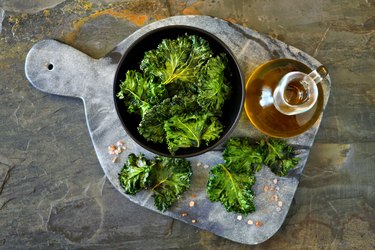
Spinach was Popeye's first choice when he needed a powerful pick-me-up, but perhaps he didn't know about raw kale. With more protein, fiber, calcium and vitamin C than the equivalent amount of spinach, as per USDA data, this leafy green packs a punch. Like spinach, you can eat it cooked or raw.
Tip
Kale is just as good eaten raw as it is cooked. A few preparation tips will help you make delicious raw kale salads.
Video of the Day
Discovering Raw Kale Nutrition
Kale is one of the most nutrient-dense foods you can eat — worthy of being called a superfood. Many people prefer it sauteed, which softens the fibrous leaves, and kale can even be roasted, which gives it a unique crunchy texture and smoky flavor. Raw kale is chewier and heartier than most other leafy greens; for some this might be a turn off, but others will find the texture appealing.
Video of the Day
With just 14 calories, one serving — 2 cups — of raw kale provides 1.2 grams of protein and 1.7 grams of fiber, per USDA data. A serving of kale is also a rich source of calcium, with about 10 percent of the recommended intake for adults, according to the Dietary Guidelines for Americans. You'll get between 45 to 50 percent of your daily needs for antioxidant vitamin C, and you'll also get a big dose of vitamin A, with 11 to 14 percent of the recommended intake per 2-cup serving.
Like other members of the cruciferous vegetable family — which includes Brussels sprouts, cauliflower and cabbage — kale is a rich source of antioxidant compounds, according to Harvard Health Publishing. These substances may provide a wealth of benefits, including protection from cancer and cardiovascular diseases.
However, raw might not be the best way to eat kale for nutrients. One cup of cooked kale weighs 130 grams, while a cup of raw kale weighs just 21 grams, so you're likely to eat more of it if you eat it cooked — thus consuming more of its nutritional goodness.
Preparing Raw Kale
Not quite sure what to do with raw kale? First, take your pick between the two most common types found at your local market — curly and dinosaur kale. They are very similar, but dinosaur kale tends to have a milder, sweeter flavor. They can be used interchangeably, so try both and see which one you like best.
There's not much to preparing raw kale. Wash it thoroughly, then pat it dry. Lay each leaf out flat and cut vertically along the spine on either side. Discard the spine or save it to use for making vegetable stock.
Cut the leaves to your desired size. You might want large pieces to put on sandwiches or even to use in place of bread. Or, you can shred the kale, which will make for more manageable mouthfuls.
Softening the leaves before adding them to your salads also makes for a more enjoyable eating experience. Place the leaves in a bowl and add a little olive oil, a squeeze of fresh lemon juice and a sprinkle of salt. Use your hands to massage these additions into the leaves, which will begin breaking down the tough fibers. Continue to rub them until soft and slightly wilted.
What you do next depends on your inspiration and tastebuds. Toss the wilted kale with pumpkin and pomegranate seeds and a little feta or goat cheese. Add some cooked quinoa to the mix to up the protein, or toss in some chunks of crispy baked tofu.
If you're in the mood for something Asian, add a touch of sesame oil and soy sauce. Mix in some sauteed zucchini noodles, a shake of red pepper flakes and crushed cashews or peanuts for a tasty lunch.
Read more: 23 Healthy Salads Nutrition Experts Eat
- USDA: "Kale, Raw"
- Dietary Guidelines for Americans: "Daily Nutritional Goals for Age-Sex Groups Based on Dietary Reference Intakes and Dietary Guidelines Recommendations"
- Harvard Health Publishing: "12 Superfoods You Should Be Eating"
- USDA: "Spinach, Raw"
- USDA: "Kale, Cooked, From Fresh, Fat Not Added in Cooking"
- Foodhero.org: Kale Basics